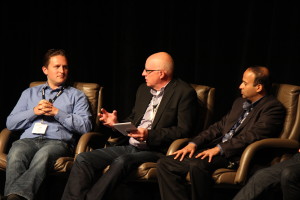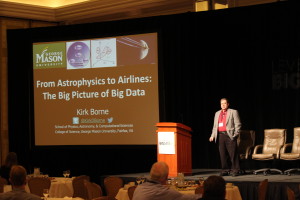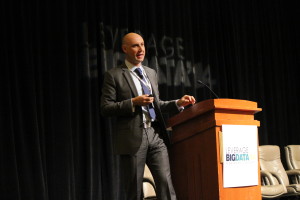If there’s one term that finds its way into nearly every conversation we have with vendors and end users on both the research and commercial spheres, it is leverage. Although it’s general, it’s being applied to everything from data, systems, software and of course, talent.
Accordingly, our inaugural event, which was held at the Park Hyatt Aviara throughout last week revolved around this one word—and all that it implies. We purposefully chucked the standard fare of “what is big data” and further, “what does big data mean to HPC” to explore in detail just how emerging and existing technologies at the top tier of computing are offering leverage to researchers and enterprise end users.
It’s amazing what happens when one kicks off a conference with a general rule to “avoid the general”. As soon as the hand-picked group was on the same page that we wouldn’t bother with questions around definitions or delineations, the real work began. And what emerged, both organically and due to subtle direction, was the theme that the cross-industry challenges of ever more complex, harder to move and manage data offered far more in the way of a common platform for discussion than one might expect. We purposefully mixed our audience and speakers—from life sciences, manufacturing, research computing, financial services, government and beyond—to dig into how the challenges around leveraging data in new, creative, and more productive ways was a common goal, and how similar tools and approaches could be adopted across wider industry contexts than any of us might have originally thought.

We had a number of notable special guests, speakers, and panel participants that offered diverse perspectives to tie together the themes, which meant that in exploring the cross-industry hook that pulled everything together, new topics emerged. Dr. Jack Collins, Director of the Advanced Biomedical Computing Center at the National Cancer Institute, revealed how new sources of complex data are pushing his team closer to cures at his home institution, but creating new challenges along the way, particularly in terms of finding adequate talent.
While his group’s mission is sweeping—a definite set of grand science challenges—the primary barrier at the National Cancer Institute isn’t caused by compute, storage, or network challenges, it’s fed by a lack of critical thinkers, problem solvers, and those with a desire for the type of lifelong learning and passion for creative approaches to analysis. While Collins did touch on how some of the hardware and software challenges impact his team’s ability to forge ahead, the top problem is quite simply people.
 Interestingly, this “people problem” inadvertently became the subject of the second half of a panel session which included Dr. Ari Berman of BioTeam; Merle Giles, who directs the Economic Impact and Private Sector Programs division at the National Center for Supercomputing Applications; Steve Yatko, former head of worldwide IT R&D at Credit Suisse and CEO of Oktay Technologies, Jack Levis, Senior Director of Process Management at UPS, and Chetan Gadgil, of GE’s Software and Analytics division. Each of the panelists shared how their progress towards data-driven goals was hindered by a lack of people with more than just pure coding skills. There appears to be a shortage of folks who have the skills and the mindset—a much more nebulous thing to define—to extract real meaning out of their data and hardware/software tools. The general consensus of the group, voiced best by Jack Levis of UPS, was that “big data” as a concept doesn’t matter. It’s all just data, the problem revolves around these side issues of getting the tooling and people in place.
Interestingly, this “people problem” inadvertently became the subject of the second half of a panel session which included Dr. Ari Berman of BioTeam; Merle Giles, who directs the Economic Impact and Private Sector Programs division at the National Center for Supercomputing Applications; Steve Yatko, former head of worldwide IT R&D at Credit Suisse and CEO of Oktay Technologies, Jack Levis, Senior Director of Process Management at UPS, and Chetan Gadgil, of GE’s Software and Analytics division. Each of the panelists shared how their progress towards data-driven goals was hindered by a lack of people with more than just pure coding skills. There appears to be a shortage of folks who have the skills and the mindset—a much more nebulous thing to define—to extract real meaning out of their data and hardware/software tools. The general consensus of the group, voiced best by Jack Levis of UPS, was that “big data” as a concept doesn’t matter. It’s all just data, the problem revolves around these side issues of getting the tooling and people in place.
 Dr. Kirk Borne, Professor of Astrophysics and Computational Scientist at George Mason University “From Astrophysics to Airlines” had similar statements on the lack of talent all around, but the takeaway from his session, which had everyone’s full attention given the scope, was about possibility. Borne showed the direct scientific and commercial benefits of large-scale data analysis through telescope and astrophysics examples, before broadening out to share how these same approaches have direct translations into manufacturing, transportation and beyond.
Dr. Kirk Borne, Professor of Astrophysics and Computational Scientist at George Mason University “From Astrophysics to Airlines” had similar statements on the lack of talent all around, but the takeaway from his session, which had everyone’s full attention given the scope, was about possibility. Borne showed the direct scientific and commercial benefits of large-scale data analysis through telescope and astrophysics examples, before broadening out to share how these same approaches have direct translations into manufacturing, transportation and beyond.
 On the tools front, Datanami editor Alex Woodie asked some tough questions of San Diego Supercomputer Center researchers, Dr. Glenn Lockwood and Predictive Analytics Center of Excellent head Dr. Natasha Balac. While the hype versus reality of Hadoop was at the heart of the panel (by the way, showing that Hadoop has a long way to go to live up to its promises in real-world large-scale settings), the duo set the groundwork for the commercial computing case studies and sessions that followed. In other words, the event steered clear of the “Hadoop will save the world” mentality that so often eclipses actual use cases—of which there are only a relative handful in large-scale full-bore production.
On the tools front, Datanami editor Alex Woodie asked some tough questions of San Diego Supercomputer Center researchers, Dr. Glenn Lockwood and Predictive Analytics Center of Excellent head Dr. Natasha Balac. While the hype versus reality of Hadoop was at the heart of the panel (by the way, showing that Hadoop has a long way to go to live up to its promises in real-world large-scale settings), the duo set the groundwork for the commercial computing case studies and sessions that followed. In other words, the event steered clear of the “Hadoop will save the world” mentality that so often eclipses actual use cases—of which there are only a relative handful in large-scale full-bore production.
 Presentations from others, including SAP’s Colin Dover hit on similar points, as did the number of case study presentations from SAP, Adaptive Computing, SGI, Bright Computing, IBM, Quanta, Penguin, and DDN offered great value for attendees, many of them end users in search of ways to meet the data deluge.
Presentations from others, including SAP’s Colin Dover hit on similar points, as did the number of case study presentations from SAP, Adaptive Computing, SGI, Bright Computing, IBM, Quanta, Penguin, and DDN offered great value for attendees, many of them end users in search of ways to meet the data deluge.
 Take a look at more photos from the event https://www.facebook.com/
Take a look at more photos from the event https://www.facebook.com/
Thanks again to our many sponsors and nGage events for making this such a success!




























































